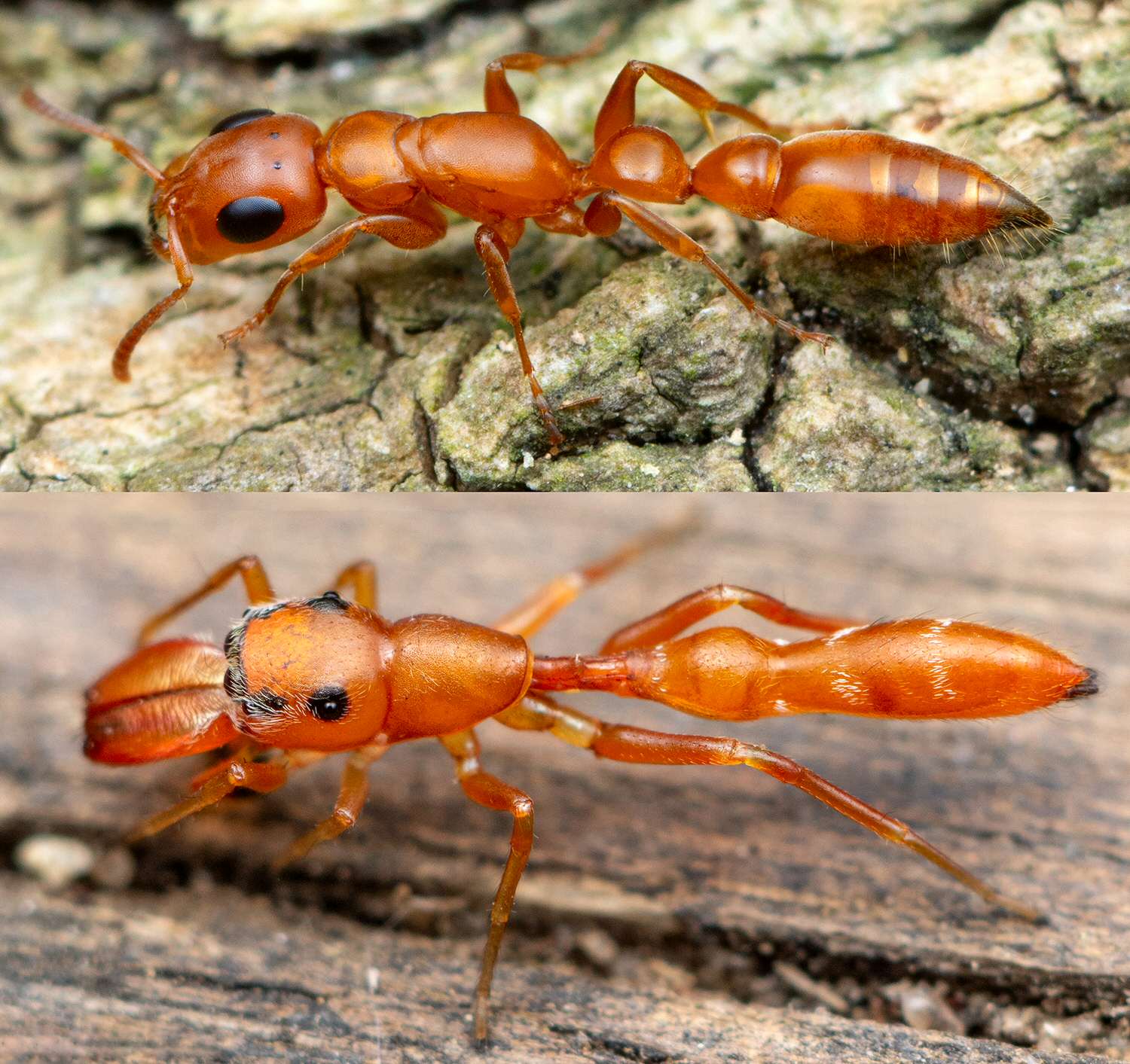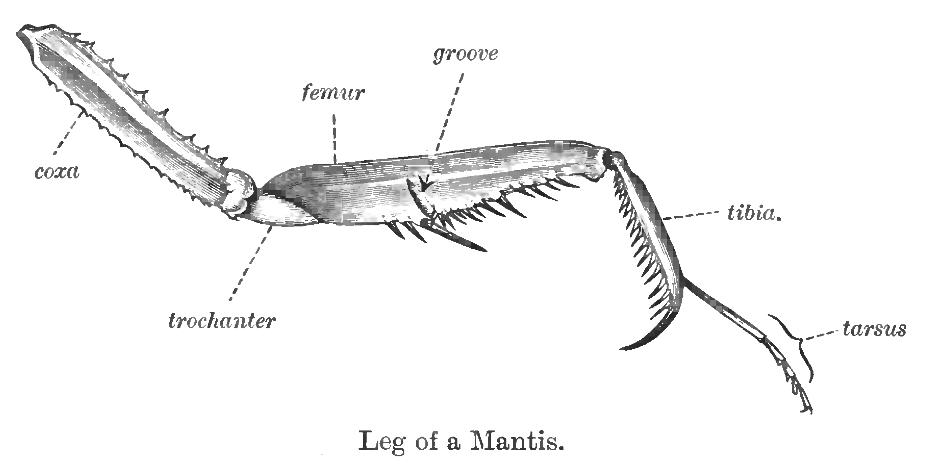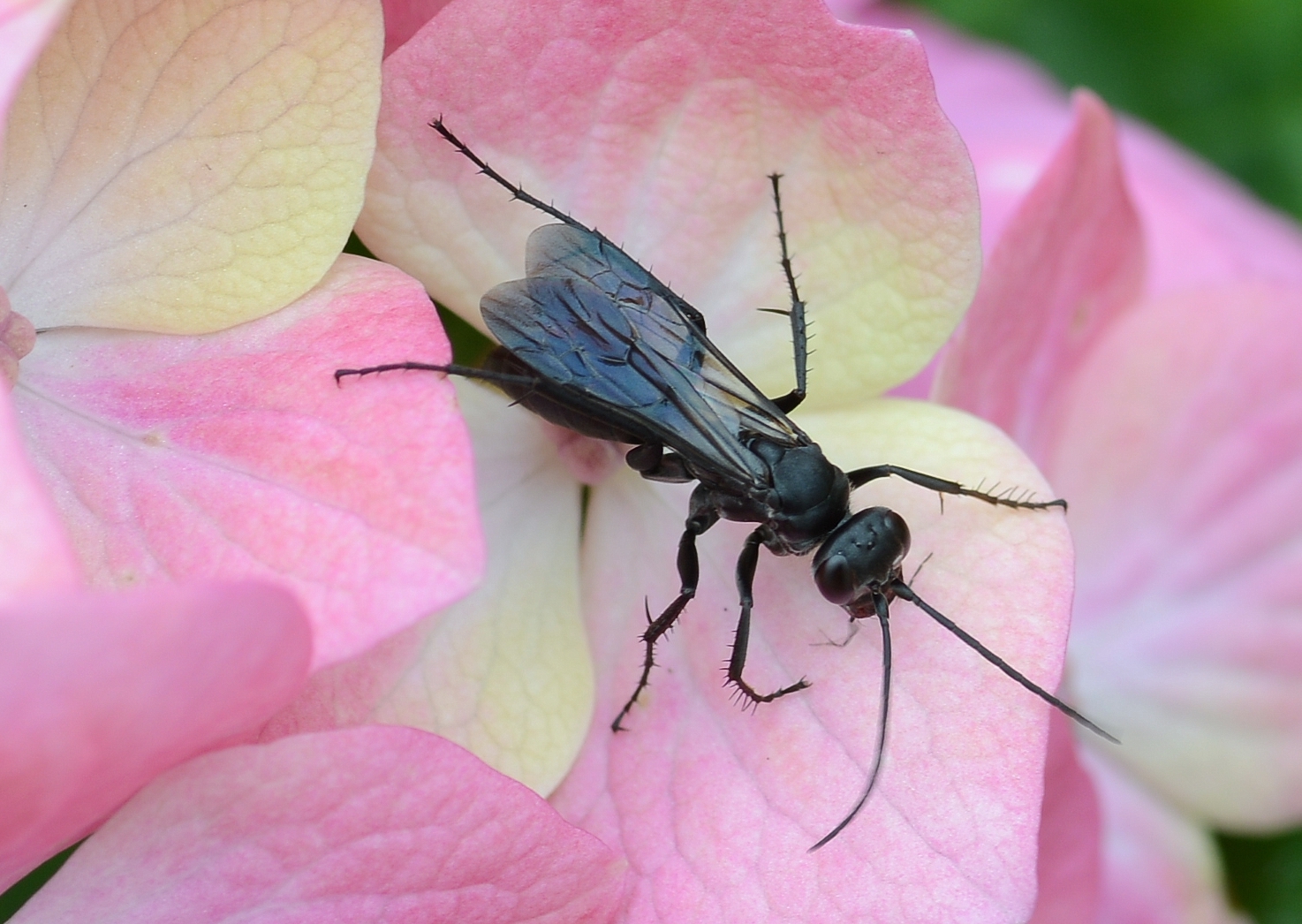|
Ant Mimicry
Ant mimicry or myrmecomorphy is mimicry of ants by other organisms. Ants are abundant all over the world, and potential predators that rely on vision to identify their prey, such as birds and wasps, normally avoid them, because they are either unpalatable or aggressive. Spiders are the most common ant mimics. Additionally, some arthropods mimic ants to escape predation (protective mimicry), while others mimic ants anatomically and behaviourally to hunt ants in aggressive mimicry. Ant mimicry has existed almost as long as ants themselves; the earliest ant mimics in the fossil record appear in the mid Cretaceous alongside the earliest ants. Indeed one of the earliest, ''Burmomyrma'', was initially classified as an ant. In Wasmannian mimicry, mimic and model live commensally together; in the case of ants, the model is an inquiline in the ants' nest. Wasmannian mimics may also be Batesian or aggressive mimics. To simulate ants' powerful defences, mimics may imitate ants chemically w ... [...More Info...] [...Related Items...] OR: [Wikipedia] [Google] [Baidu] |
Ant And Jumping Spider Gorongosa National Park, Mozambique
Ants are eusocial insects of the family Formicidae and, along with the related wasps and bees, belong to the order Hymenoptera. Ants evolved from vespoid wasp ancestors in the Cretaceous period. More than 13,800 of an estimated total of 22,000 species have been classified. They are easily identified by their geniculate (elbowed) antennae and the distinctive node-like structure that forms their slender waists. Ants form colonies that range in size from a few dozen predatory individuals living in small natural cavities to highly organised colonies that may occupy large territories and consist of millions of individuals. Larger colonies consist of various castes of sterile, wingless females, most of which are workers (ergates), as well as soldiers (dinergates) and other specialised groups. Nearly all ant colonies also have some fertile males called "drones" and one or more fertile females called "queens" (gynes). The colonies are described as superorganisms because the ants appea ... [...More Info...] [...Related Items...] OR: [Wikipedia] [Google] [Baidu] |
Macroxiphus Sp Cricket
''Macroxiphus''Pictet (1888) ''Mem. Soc. Phys. Hist. Nat. Geneve'' 30(6): 52. is a small genus of bush crickets or katydids distributed in Southeast Asia and Micronesia. The nymphs (immature stages) of the insects mimic ants. Species Species include: *'' Macroxiphus nasicornis'' Pictet, 1888 - type species *'' Macroxiphus sumatranus'' (Haan, 1843) Camouflage and mimicry Young instars of ''Macroxiphus'', such as '' M. sumatranus'', have an "uncanny resemblance" to ants, extending to their black coloration, remarkably perfect antlike shape, and convincingly antlike behaviour. Their long antennae are camouflaged to appear short, being black only at the base, and they are vibrated like ant antennae. Larger instars suddenly change into typical-looking katydids, and are entirely nocturnal, while the adult has bright warning coloration Aposematism is the advertising by an animal to potential predators that it is not worth attacking or eating. This unprofitability may consist of ... [...More Info...] [...Related Items...] OR: [Wikipedia] [Google] [Baidu] |
Mantidae
Mantidae is one of the largest families in the order of praying mantises, based on the type species ''Mantis religiosa''; however, most genera are tropical or subtropical. Historically, this was the only family in the order, and many references still use the term "mantid" to refer to any mantis. Technically, however, "mantid" refers only to members of the family Mantidae, and not the 14 remaining families of mantises. Some of the most recent classifications have promoted a number of the mantid subfamilies to the rank of family, e.g. Iridopterygidae, Sibyllidae, Tarachodidae, Thespidae, and Toxoderidae, while other classifications have reduced the number of subfamilies without elevating to higher rank. Subfamilies and genera Following the major revision of the Mantodea in 2019, the ''Mantodea Species File'' includes ten subfamilies: Choeradodinae The Americas, Asia * '' Asiadodis'' Roy, 2004 * ''Choeradodis'' Serville, 1831 * †'' Prochaeradodis'' Piton, 1940 Deroman ... [...More Info...] [...Related Items...] OR: [Wikipedia] [Google] [Baidu] |
Genus Synageles Spider
Genus ( plural genera ) is a taxonomic rank used in the biological classification of living and fossil organisms as well as viruses. In the hierarchy of biological classification, genus comes above species and below family. In binomial nomenclature, the genus name forms the first part of the binomial species name for each species within the genus. :E.g. ''Panthera leo'' (lion) and ''Panthera onca'' (jaguar) are two species within the genus ''Panthera''. ''Panthera'' is a genus within the family Felidae. The composition of a genus is determined by taxonomists. The standards for genus classification are not strictly codified, so different authorities often produce different classifications for genera. There are some general practices used, however, including the idea that a newly defined genus should fulfill these three criteria to be descriptively useful: # monophyly – all descendants of an ancestral taxon are grouped together (i.e. phylogenetic analysis should clearly demonstr ... [...More Info...] [...Related Items...] OR: [Wikipedia] [Google] [Baidu] |
Spider Wasp
Wasps in the family Pompilidae are commonly called spider wasps, spider-hunting wasps, or pompilid wasps. The family is cosmopolitan, with some 5,000 species in six subfamilies. Nearly all species are solitary (with the exception of some group-nesting Ageniellini), and most capture and paralyze prey, though members of the subfamily Ceropalinae are kleptoparasites of other pompilids, or ectoparasitoids of living spiders. In South America, species may be referred to colloquially as or , though these names can be generally applied to any very large stinging wasps. Furthermore, in some parts of Venezuela and Colombia, it is called , or "horse killers", while in Brazil some particular bigger and brighter species of the general kind might be called /, or "throat locker". Morphology Like other strong fliers, pompilids have a thorax modified for efficient flight. The metathorax is solidly fused to the pronotum and mesothorax; moreover, the prothorax is best developed in Pompilidae a ... [...More Info...] [...Related Items...] OR: [Wikipedia] [Google] [Baidu] |
Animal Locomotion
Animal locomotion, in ethology, is any of a variety of methods that animal (biology), animals use to move from one place to another. Some modes of locomotion are (initially) self-propelled, e.g., running, swimming, jumping, flying, hopping, soaring and gliding. There are also many animal species that depend on their environment for transportation, a type of mobility called Passive locomotion in animals, passive locomotion, e.g., sailing (some jellyfish), Ballooning (spider), kiting (spiders), rolling (some beetles and spiders) or riding other animals (phoresis (biology), phoresis). Animals move for a variety of reasons, such as to find Foraging, food, a Mating system, mate, a suitable microhabitat, or to Escape response, escape predators. For many animals, the ability to move is essential for survival and, as a result, natural selection has shaped the locomotion methods and mechanisms used by moving organisms. For example, Animal migration, migratory animals that travel vast dista ... [...More Info...] [...Related Items...] OR: [Wikipedia] [Google] [Baidu] |
Myrmarachne
''Myrmarachne'' is a genus of ant-mimicking jumping spiders that was first described by W. S. MacLeay in 1839. They are commonly called antmimicking spiders, but they are not the only spiders that have this attribute. The name is a combination of Ancient Greek ('' myrmex''), meaning "ant", and (''arachne''), meaning "spider". This genus has undergone many changes, and is still under review as more information becomes available. In 2016, several genera were split off, including ''Helicius'' and the monotypic genus '' Panachraesta''. The genus '' Emertonius'' was revalidated in 2018 after being synonymized with ''Myrmarachne'' for nearly thirty years. Description ''Myrmarachne'' have an elongated cephalothorax with relatively long chelicerae that projects forward in males. The cephalothorax has a waist, and the opisthosoma often has one too. The colors can vary from black to yellow, depending on ant species it is mimicking, and can change over the course of its life. For example, ... [...More Info...] [...Related Items...] OR: [Wikipedia] [Google] [Baidu] |
Jumping Spider
Jumping spiders are a group of spiders that constitute the family (biology), family Salticidae. As of 2019, this family contained over 600 described genera and over 6,000 described species, making it the largest family of spiders at 13% of all species. Jumping spiders have some of the best vision among arthropods and use it in courtship, hunting, and navigation. Although they normally move unobtrusively and fairly slowly, most species are capable of very agile jumps, notably when hunting, but sometimes in response to sudden threats or crossing long gaps. Both their book lungs and Invertebrate trachea, tracheal system are well-developed, and they use both systems (bimodal breathing). Jumping spiders are generally recognized by their eye pattern. All jumping spiders have four pairs of eyes, with the Anatomical terms of location, anterior median pair being particularly large. Distinguishing characteristics Jumping spiders are among the easiest to distinguish from similar spider f ... [...More Info...] [...Related Items...] OR: [Wikipedia] [Google] [Baidu] |
Ant Mimic Spider
Ants are eusocial insects of the family Formicidae and, along with the related wasps and bees, belong to the order Hymenoptera. Ants evolved from vespoid wasp ancestors in the Cretaceous period. More than 13,800 of an estimated total of 22,000 species have been classified. They are easily identified by their geniculate (elbowed) antennae and the distinctive node-like structure that forms their slender waists. Ants form colonies that range in size from a few dozen predatory individuals living in small natural cavities to highly organised colonies that may occupy large territories and consist of millions of individuals. Larger colonies consist of various castes of sterile, wingless females, most of which are workers (ergates), as well as soldiers (dinergates) and other specialised groups. Nearly all ant colonies also have some fertile males called "drones" and one or more fertile females called " queens" (gynes). The colonies are described as superorganisms because the a ... [...More Info...] [...Related Items...] OR: [Wikipedia] [Google] [Baidu] |
Warning Coloration
Aposematism is the advertising by an animal to potential predators that it is not worth attacking or eating. This unprofitability may consist of any defences which make the prey difficult to kill and eat, such as toxicity, venom, foul taste or smell, sharp spines, or aggressive nature. These advertising signals may take the form of conspicuous coloration, sounds, odours, or other perceivable characteristics. Aposematic signals are beneficial for both predator and prey, since both avoid potential harm. The term was coined in 1877 by Edward Bagnall Poulton for Alfred Russel Wallace's concept of warning coloration. Aposematism is exploited in Müllerian mimicry, where species with strong defences evolve to resemble one another. By mimicking similarly coloured species, the warning signal to predators is shared, causing them to learn more quickly at less of a cost. A genuine aposematic signal that a species actually possesses chemical or physical defences is not the only way to d ... [...More Info...] [...Related Items...] OR: [Wikipedia] [Google] [Baidu] |
Nocturnal
Nocturnality is an animal behavior characterized by being active during the night and sleeping during the day. The common adjective is "nocturnal", versus diurnal meaning the opposite. Nocturnal creatures generally have highly developed senses of hearing, smell, and specially adapted eyesight. Some animals, such as cats and ferrets, have eyes that can adapt to both low-level and bright day levels of illumination (see metaturnal). Others, such as bushbabies and (some) bats, can function only at night. Many nocturnal creatures including tarsiers and some owls have large eyes in comparison with their body size to compensate for the lower light levels at night. More specifically, they have been found to have a larger cornea relative to their eye size than diurnal creatures to increase their : in the low-light conditions. Nocturnality helps wasps, such as ''Apoica flavissima'', avoid hunting in intense sunlight. Diurnal animals, including squirrels and songbirds, are active du ... [...More Info...] [...Related Items...] OR: [Wikipedia] [Google] [Baidu] |









